

Climate Change Could Make Borrowing More Expensive. Hurricane Maria was devastating for the residents of Puerto Rico.

It hurt debt investors, too. Some of the island’s bonds plunged more than 40 percent after the storm flooded the island, knocked out its electric power, and clobbered its economy. Now bond rating agencies such as Moody’s Investors Service and S&P Global Ratings are looking at whether they should be including more disaster forecasting in calculating the grades they give to government debt and to companies in industries ranging from insurance to construction.
The agencies have looked at these risks for years and issued reports on them, but in recent months they’ve been working to integrate this research more into individual ratings. In November, Moody’s warned coastal cities and states to address their climate risks or face possible downgrades. In the U.S., costly natural disasters are becoming more common. Audio: What does a changing climate mean for California's infrastructure? The recent fires and rains in Southern California have led to mudslides, debris flows and rock falls along the Santa Barbara County coast.
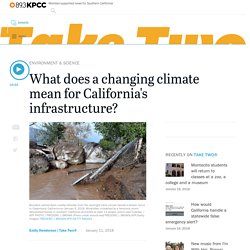
At least 17 people have died, dozens of homes have been destroyed and, in the coastal village of Montecito, the water system was severely damaged. With extreme weather becoming the norm in California, Take Two reached out to Stanford University earth science professor, Noah Diffenbaugh, to learn more about the state's infrastructure and its level of preparedness for natural disasters. El Niño. Warm phase of a cyclic climatic phenomenon in the Pacific Ocean Normal Pacific pattern: Warm pool in the west drives deep atmospheric convection.
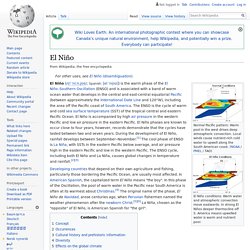
Local winds cause nutrient-rich cold water to upwell along the South American coast. (NOAA / PMEL / TAO) El Niño conditions: Warm water and atmospheric convection move eastwards. Atlantic Equatorial mode. The Atlantic Equatorial Mode or Atlantic Niño is a quasiperiodic interannual climate pattern of the equatorial Atlantic Ocean.
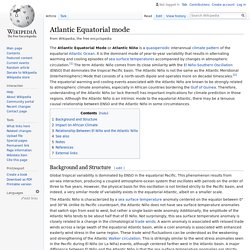
It is the dominant mode of year-to-year variability that results in alternating warming and cooling episodes of sea surface temperatures accompanied by changes in atmospheric circulation.[1] The term Atlantic Niño comes from its close similarity with the El Niño-Southern Oscillation (ENSO) that dominates the tropical Pacific basin. Preparing for an Uncertain Future: Doing “Scenario Planning” in Boulder - 100 Resilient Cities. Boulder, a small city in the foothills of the Rocky Mountains, is one of many communities already experiencing the harsh reality of climate change—the fact that future weather and climate will diverge from that of the past.

In 2010, unusually hot and dry conditions led to fires that torched 162 homes. Three years later, in September 2013, the City experienced massive flooding when a 1000-year storm dropped the entire annual precipitation within in just one week. The only thing absolutely certain about Boulder’s future is that the City will face many more such extreme weather events, even as it deals with social and economic stresses. So can cities or communities plan for an uncertain future? To answer this question, Boulder has been exploring a concept known as “scenario planning.” 3 charts that illustrate the health impact of global climate change. NASA Pinpoints Cause of Earth's Recent Record Carbon Dioxide Spike. The world just warmed on its own: NASA finds heat-blasted tropical forests emitted more carbon than China. Despite humans finally beginning to address their carbon output, a cutting-edge NASA study has found that the world’s El Nino-stricken forests single-handedly sent global emissions into overdrive in 2016.
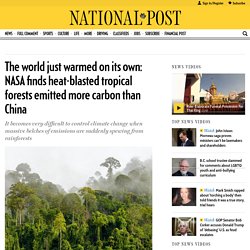
In lush areas of Africa, South America and Indonesia, dried and rotting forests were responsible for the “largest annual increases in atmospheric carbon dioxide concentration seen in at least 2,000 years,” reads an October statement issued by NASA’s Jet Propulsion Laboratory. The forests’ final tally, as recorded by a new NASA earth satellite, was 2.5 billion tonnes of extra carbon emissions, putting them in close contention to beat China as the world’s heaviest emitter.
For context, 2.5 billion tonnes is equivalent to 13 Canadas worth of emissions or 3.75 Indias. The massive release singlehandedly raised global carbon emissions by more than 50 per cent, from an average of 4 gigatons to the record-breaking 6.3 gigatons seen in 2015/2016. Climate Change And The Migration Crisis. INTERVIEW: Few global issues as urgent as tackling climate and disaster risks – UN official. Citizens must 'flood the courts' in fight for climate justice, says Jeff Sachs. The world faces a ticking time bomb in the form of global warming, and recent disasters caused by extreme weather should motivate individuals to urgently seek “climate justice”, said leading US economist Jeffrey Sachs.

The UN special adviser urged citizens to “flood the courts” with legal cases demanding the right to a safe and clean environment, and to pursue major polluters such as big oil companies and negligent governments for liability and damages. “Who’s going to rebuild? Who’s going to pay?” Asked Sachs, referring to a spate of disasters, including floods and storms, which scientists say are being exacerbated by climate change. Thirsty Sea of Galilee sinking toward lowest level ever recorded. Our planet is facing a dire water... - Israel Ministry of Foreign Affairs. Force of Hurricane Irma displayed as it sucks water from Bahamas beach. Climate Council. Angry Summer 2016/17: Climate Change Super-Charging Extreme Weather. The Climate Council of Australia collects your personal information when you make a donation to support our work.

We collect this information so that we can process your donation, and send you a receipt, and so that we can contact you in the future and keep you updated with all the latest information on our research and activities. We may also use your information for other purposes, as described in our privacy policy. If we do not collect your personal information, you may not be able to make the donation or to receive a receipt or other communications from us. How People Can Best Make the Transition to Cool Future Cities. It is difficult to remember when we are in the midst of winter, but keeping cool in summer is a big issue for some communities.
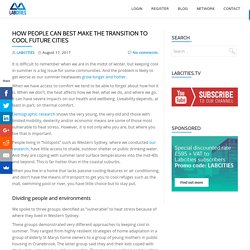
And the problem is likely to get worse as our summer heatwaves grow longer and hotter. When we have access to comfort we tend to be able to forget about how hot it is. Global Drought Prediction Tool: SPI Multi-Model Ensemble Forecast. Gizmodo. Scrapping Climate Protections Would Erase $300 Billion in Benefits, Study Finds. Extreme weather becoming more common, study says. Extreme weather like the drought currently scorching the western US and the devastating floods in Pakistan in 2010 is becoming much more common, according to new scientific research.
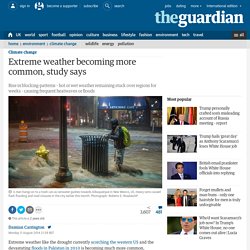
The work shows so-called “blocking patterns”, where hot or wet weather remains stuck over a region for weeks causing heatwaves or floods, have more than doubled in summers over the last decade. The new study may also demonstrate a link between the UK’s recent flood-drenched winter and climate change. Climate scientists in Germany noticed that since 2000 there have been an “exceptional number of summer weather extremes, some causing massive damage to society”. Siberian craters: Big releases of methane could pose broad problems. Since 2014, several massive sinkholes have been discovered in the region. The first one reportedly measured over 50 ft wide. In Alaska, Climate Change Threatens to Sweep Away the Village of Newtok. NEWTOK, Alaska—Two decades ago, the people of this tiny village came to terms with what had become increasingly obvious: They could no longer fight back the rising waters. Their homes perched on a low-lying, treeless tuft of land between two rivers on Alaska’s west coast, residents saw the water creeping closer every year, gobbling up fields where they used to pick berries and hunt moose.
Paul and Teresa Charles watched from their blue home on stilts on Newtok’s southern side as the Ninglick River inched closer and closer, bringing with it the salt waters of the Bering Sea. Cities in Russia may COLLAPSE by 2050 due to thawing permafrost. Towns and cities across the east of Vladimir Putin's vast empire could 'collapse' in the coming decades because of thawing permafrost. Ground that was once solid is crumbling due to climate change, and the impact for buildings across Arctic and Siberian regions will be 'devastating' by 2050, says a new US-Russian report.
Problems are expected even sooner in Anadyr, the capital of the extreme eastern region on Chukotka, where Chelsea tycoon Roman Abramovich once served as governor. Gas pipelines supplying Europe 'in real danger from exploding tundra' - top scientist. Yerkutinskaya funnel. Connecting countries to climate technology solutions. Iceberg the size of Delaware, among biggest ever recorded, snaps off Antarctica. Welcome to About UNEP. The Earth Institute - Columbia University. Growing Forests in the Desert. Sandbag - Smarter climate policy.
Climate Access - Home. FutureCamp. InsideClimate News. Climate Change news. Climate Home - climate change news. The Earth Institute - Columbia University. Sandbag - Smarter climate policy. הקואופרטיב לאנרגיות מתחדשות.